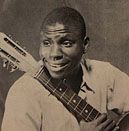By Vladimir Cagnolari
The first selection gathers two mainstreams: the fight for the human rights and the opposition that brought mass murder and slavery.
Both embodied by famous figures. Never forgotten, the beauty of this land also sung in this first PAM post.
Listen to the playlist :
Le Bûcheron (The Bucheron (track 1 – SPOTIFY), by the great Franklin Boukaka. The bucheron who struggles to feed his family selling woods through the Congolese forests.
Africa, where is your independence where is your freedom ?
Cutting wood is hard work, selling it is an other
With all troubles and feeding my children, pulling through sounds like heaven
Boukaka records this in Paris 1970 with Manu Dibango head of orchestra, arrangements and sax.
Through years his revolutionary and committed lyrics cause troubles with the government in Brazzaville.
The ones I gave my poll to became greedy for power and fancy cars
When the elections show up I’m great again and I ask myself: the colonizer has gone who did we obtain independence for?
Boukaka died age 32 when the putsch attempt was solved by President Marien Ngouabi by blood . Boukaka left his own life, that etched his African ideals for ever.
To win back independence for the colonized was sometimes quite easy but also caused lots of wars in the 70’s.Territories under Portuguese ward like Mozambique and Angola or British colonies such as Rhodesie called Zimbabwe since 1980.
Congolese Franco Lumbo from Kinshasa raises these subjects in Mambu Na Miondo (pl2). It was powerful because of it’s recognised art.
The emancipation of black Africans was soon gathered with the liberation of all black population. Africa lately sang by Djelimady Tounkara in Farafina Africa (pl 3 ) and by the U.S.
Pan-Africanism saw its figureheads erase at that moment. Kwame Nkrumah went around with intellectuals and activists he met in schooling in London and the U.S they were all from world Diaspora. When he became first president of Ghana he declared:” Our independence is meaningless unless it is linked up with the total liberation of Africa”.
Ghana is the first African country to be free, and this freed sound flies all over to London clubs where Calypso is trendy (birth of Ghana track 3).
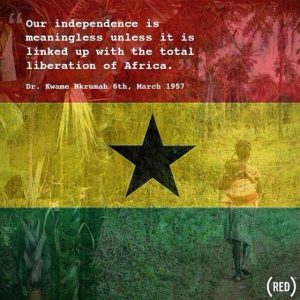
The black star in the middle of Ghanaian flag symbolizes African freedom. It has certainly to do with the ship company created by Marcus Garvey Black Star Line to bring black men back home. Garvey figure of Rastafarian as well as Hale Selassie, Ethiopian Emperor sang by Jamaican Rod Taylor.
Ethiopia only was never colonized so the green yellow red color of its flag is a symbol for many African states.
One more Man was Patrice Emery Lumumba prime minister of Congo released on 30 June 1960.
One more Man was Patrice Emery Lumumba prime minister of Congo released country on 30 June 1960.
Shot on 17 January 1961 by colonel Mobutu and his army, and given to Moise Tshombé and his Belgian army…He could have been iconic…Many tribute were given: like Guinean from Conakry Bala Oniavogui and his orchestra The Balladins.(pl 6).
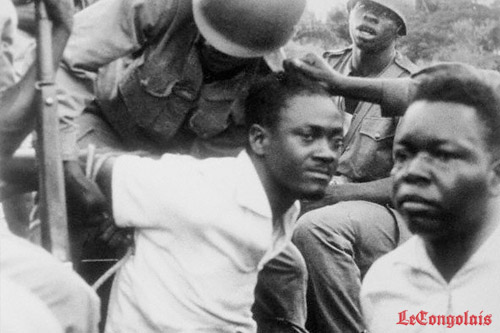
Patrice Emery Lumumba
1969 Fela Randsome Kuti and his band record Viva Nigeria (pl 7) in the U.S. War in Biafra is on peak and his plead for peace aims all Africa.
Ni Mafele song (pl 8) is all about the blood that never stopped flowing until now in Africa.
Performer Sekouba Bambino is worried about children fate, children huge victims, often forced to enroll since 90’s.
Ismael lo sings peace (Jammu) in the beautiful Jammu Africa track (pl 9).
Unity claimed by Senegalese Baaba Maal (pl 10) as well as Omar Pene should we not forget, he encourages people to change the war target and fight against the real problem such as paludism and other plagues that gangrenes Africa.
1976 Pierre Akendengue sings for the 54 African states issues in Nandipo, his latest release.
Africa Obata (pl 12) outcome from his beginnings recorded with Brazilian drummer Nana Vasconcelos who passed away last march 9.
[metaslider id=340]
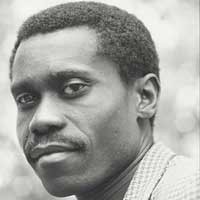
Pierre Akendengué
Next week in PAM #2 we will praise for to often forgotten genius P.Akendengue.
There is no woman approach here but we can’t forget « Mamma Africa ».
Myriam Makeba left South Africa in the 1960’s because of her public commitment and extol against Apartheid. She couldn’t come back until the 90’s.
1959 she took part in movie shooting “Come Back Africa” before an American musical tour.
See an extract here.
Sophiatown is gone (pl 13) is a song about the end of a district where black Africans could own proprieties and be free. Jazz was flowing as much as corn beer.
South African government razed the city and renamed it Triumph. The 65 000 inhabitants were thrown out, most of whom were relocated in Soweto township.
South African Jurgen Schaderberg (www.jurgenschadeberg.com) shows us Sophiatown atmosphere in most of his clichés. Before him Ali Farka did such with Rye Cooder , they recorded a track with American bluesman Taj Mahal.(pl 16)
To the infinite list of « when Africa sings Africa » can be added the famous African typic collection (pl 14) performed by Sam Fan Thomas from Cameroun. Success in the mid 80’s. A medley of musical styles and far famed melodies like the song Boma l’heure from Franco Luambo.
As a conclusion to this African trip (we will get back into it later on) other musical trends can and will be found all along Atlantic coast, afro Cuban or salsa music for example.
America and Caribbean rhythms were influenced by the American flow.
Cuban music than came back on the continent. With Independence was born the afro Cuban trend in Africa.
One of the best pictures of this performance is Africando instituted by Ibrahim Sylla. Africa Es, Tribute to Africando is one track of latest album Viva Africa.
It is played by Spanish Harlem Orchestra (pl 15) as a tribute to African roots in Latin American swings.
Once again we can find African influences in the northern American tempos. What is called blues by musicians along Mississippi is Poyed for Malians, says Bassekou Kouyaté.
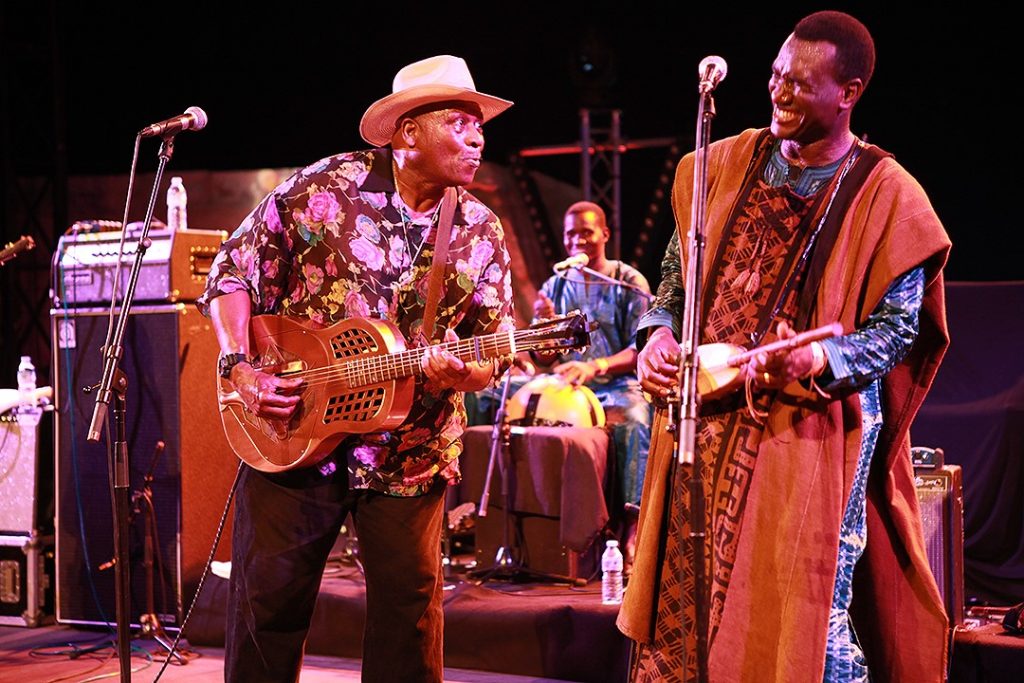
Taj Mahal et Bassekou Kouyaté, en concert au festival Fiestasète (aout 2013)
Off course Africa has so much links with America. Africa Unit is one of the best pan-africanism example performed by the reggae ambassador and most famous in the world Bob Marley.
To end on a good vibe, here is a track “buy Africa “by Fela Kutti. Signed by rapper Belgian Congo Balogi in association with singer Kuku. (pl 18).
[metaslider id=433]
See you next week on PAM#2, dedicated to Pierre Claver Akendengue.
Par Vladimir Cagnolari
Follow Pan African Music :
Tracklisting :
- Franklin Boukaka / Le Bûcheron
- Mambu na miondo, Franco
- Farafina Africa, Djelimady Tounkara
- Birth of Ghana, Lord Kitchener
- His Imperial Majesty, Rod Taylor
- Lumumba, Balla et ses balladins
- Fela Ransome Kuti, Viva Africa
- Ni Mafele, Sekouba Bambino
- Ismael Lo, Jammu Africa
- Africa United, Baaba Maal
- Omar Pene, Africa
- Afrika Obota, Akendengue
- Myriam Makeba, Sophiatown is gone
- African Typic collection, Sam Fan Thomas
- Africa Es, tribute to africando
- Poye 2, B. Kouyate & Taj Mahal
- Africa Unite, Bob Marley
- Buy Africa, Baloji

